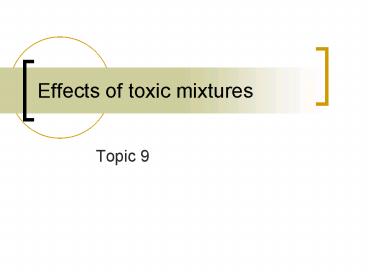Effects of toxic mixtures - PowerPoint PPT Presentation
1 / 24
Title:
Effects of toxic mixtures
Description:
To understand additivity, antagonism and synergism between contaminants ... Synergism ... How to determine antagonism or synergism of contaminants? Toxic units ... – PowerPoint PPT presentation
Number of Views:663
Avg rating:5.0/5.0
Title: Effects of toxic mixtures
1
Effects of toxic mixtures
- Topic 9
2
Learning objectives
- To learn and to understand the concept of toxic
units - To understand additivity, antagonism and
synergism between contaminants - Apply your knowledge to determine from an
example whether contaminants act synergistically,
antagonistically or have an additive effect
3
Toxic mixtures
- From one dimension to multi-dimensional world
4
Effects of individual toxicants vs toxic mixtures
I Crazy math
- Additivity
- Toxicity of the mixture of toxicants A and B is
the same as the sum of toxicities of toxicants A
and B when applied individually - 224
5
Effects of individual toxicants vs toxic mixtures
II Crazy math
- Antagonism
- Toxicity of the mixture of toxicants A and B is
lower than the sum of toxicities of toxicants A
and B when applied individually - 222
6
Effects of individual toxicants vs toxic mixtures
III Crazy math
- Synergism
- Toxicity of the mixture of toxicants A and B is
higher than the sum of toxicities of toxicants A
and B when applied individually - 226
- Potentiation
- One chemical, which is not toxic on its own,
enhances toxicity of the second chemical in the
mixture - 204
7
How to determine antagonism or synergism of
contaminants?
8
Toxic units
- Concentrations of toxicants expressed in units of
lethality or in units of effect (relative to
LD50, LC50 or EC50) - Chemical A has LD50 of 100 ?M.
- 1 TU100 ?M
- 50 ?M?
100 ?M
Concentration of A High Low
9
Toxic units (cont.)
- Chemical B has LD50 of 50 ?M.
- 1 TU50 ?M
- 0.5 TU?
50 ?M
Concentration of B High Low
10
Toxic units (cont.)
- Take a mixture containing 50 ?M A and 25 ?M B
- How many toxic units does it contain?
11
Additive index (Marking Dawson 1975)
S1 additivity Slt1 toxicants are
antagonistic Sgt1 toxicants are synergistic
12
Synergism
Additivity
Toxic units
Antagonism
13
In-class exercise
- Determine whether two toxin have additive,
synergistic or antagonistic effects in the mixture
14
Mechanisms of antagonism
15
Antagonism
- Functional
- Chemical
- Dispositional
- Receptor antagonism
16
Functional antagonism
- Two chemicals having opposite physiological effect
ROS
DMSO
Cu2
Cu2 DMSO no effect or less effect
17
Chemical antagonism
- Chemicals in the mixture combine to produce a
less toxic complex - Organic acids chelation of heavy metals
- 2CN-Cd2 -gt Cd(CN)2
18
Dispositional antagonism
- When one toxicant affects uptake, transport or
elimination of the other - Zn2 often reduces Cd2 uptake in a mixture
- Ethanol enhances mercury elimination in mammals
19
Receptor antagonism
- Two or more toxicants bind to the same receptor
and each toxicants blocks the other from fully
expressing toxicity
CO
O2
20
Synergism
- The combined effect of two or more contaminants
is stronger than their additive effects - Often contaminants that act through the same
mechanisms show additive or antagonistic effects,
and those that have different mechanisms act
synergistically 19 organic toxicants in E. coli
Chen Lu (2002)
21
Synergistic effects of PCBs and methylmercury on
brain function in birds
Bemis Seegal (1999) EHP
22
Potentiation
- Enhancement of the effects of a toxicant by a
non-toxic compound
23
CYP450
24
Take-home messages
- Toxicity of contaminant mixtures is not directly
predictable from the toxicity of single compounds - The only reliable way to determine toxicity of
mixtures is testing although understanding of the
mechanisms of action of each component may help
to make a priori predictions - Toxicity of mixtures is important because in the
environment the toxicants come in mixtures!

